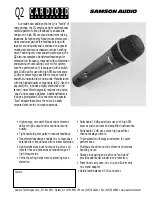
3
Temperature and pressure will affect the sensitivity of a microphone but these effects can be accounted
for by adjusting the recorded microphone values using the coefficients specified for each microphone
model. Simply calculate the difference in temperature and ambient pressure from those recorded during
calibration and multiply this value by the proper coefficient to determine the sensitivity offset. In most
cases, the offset will be very small and is therefore unnecessary.
5.0
Accessories
Transducer Electronics Data Sheet (TEDS)
Preamplifiers can incorporate TEDS devices, which have a built in read/write memory that contains rele-
vant information about the sensor and its use. Information includes manufacturer name, model number,
serial number, sensitivity, etc. The operation of TEDS devices is defined by IEEE P1451.4. A TEDS mi-
crophone system includes a microphone mated with a preamplifier that contains the TEDS memory pro-
grammed with both the microphone and preamplifier information. This is particularly helpful when using
large channel count systems and array set-up.
A-Weight Inline Filter
The inline filter is used in conjunction with an ICP
®
preamplifier to provide A-weighting for acoustical
measurements. The filter’s frequency response is weighted according to the A-weighting filter portion of
both ANSI S1.4 and IEC 60651 Type 1 Sound Level Meter Standards. ICP
®
signal conditioners of 4 mA
or greater are recommended when using inline filters.
Windscreens and Nose cones
Wind induced noise can be reduced by using a windscreen. This can offer some protection against dust
particles and mechanical damage. In the presence of high-speed airflow from a well-defined direction,
such as wind tunnels, a nose cone is recommended. When using windscreens and noise cones, the fre-
quency response of the microphone will be attenuated at higher frequencies.
Clamps and stands
When holding a microphone in place, it is important to minimize the influence of the stand on the sound
being measured. This can be accomplished by using low profile stands and clamps available from PCB.
Cables and Electronics
PCB carries LEMO
cables as well as coaxial cables with BNC and 10-32 connectors. Traditional exter-
nally polarized microphone power supplies along with a variety of ICP
®
signal conditioners are available
that will fit almost any need.
6.0
Maintenance
Microphones are very stable over long periods of time, provided they are handled and stored properly.
The microphone contains fragile components that can be damaged by misuse, in particular the diaphragm,
which is made up of a very thin proprietary material and should be kept clean of dust, dirt, moisture and
free any type of imperfection (scratch, dent, etc.).
The microphone’s grid cap is designed to let the true sound pressure level through to the diaphragm while
preventing items from coming in contact with it. We do not recommend that you ever remove the grid cap
or clean the microphone. If you take the precautionary measures to keep the microphone clean and dry, it
should not be necessary. Use of accessories, like windscreens, and desiccants will help keep moisture off
the microphone and maintain the specified sensitivity level. Nose cones will help keep turbulence off the
microphone diaphragm and allow the sound pressure to be measured with greater accuracy.
Keep the microphone and preamplifier assembled while preparing for testing. Keep the rubber mainte-
nance caps on the preamplifier’s electrical connector only. Do not place these rubber caps over the micro-
phone. This will create a vacuum and undo pressure on the microphone diaphragm, which can stretch the
diaphragm and cause a change in sensitivity. Store the microphones and preamplifiers in their protective



























